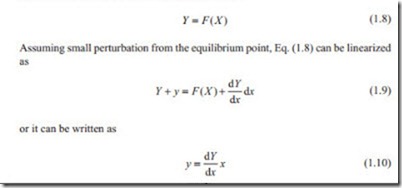Linearization Technique
If there is a continuous nonlinearity in the form of
Feedback Control Theory
In Eqs. (1.10) and (1.9) x, y represent small perturbation from the equilibrium point. Equation (1.10) can be written as
K is constant at an operating point. Throughout this book, the lower case variable represents small perturbation from equilibrium point. This is shown in Fig. 1.3.
Equation (1.8) represents one variable system. For a multivariable system, similar linearized equation can be obtained.
The solution of the governing equation simplifies if Laplace Transform is used.
Related posts:
CIRCUIT BREAKERS:CONVENTIONAL CIRCUIT BREAKERS AND METHODS FOR INCREASING ARC RESISTANCE
Other Digital Audio Devices:WAV Onward
POWER ELECTRONICS, RECTIFIERS, AND PULSE-WIDTH MODULATION INVERTERS:PULSE SYNCHRONIZATION AND VOLTAG...
Electric Motor Manual – SELECTION AND APPLICATION – Special ac motors and their applicat...
AUDIO AND VIDEO SYSTEMS - ELECTRONIC MUSIC SYNTHESIZERS
INTRODUCTION TO NETWORKING WIRED AND WIRELESS
Meters - MAGNETIC-VANE METERS
MAINTENANCE OF MOTORS:CHARACTERISTICS OF MOTORS
Measurement:Semitone Intervals
TRANSFORMERS:THE DOT CONVENTION
ELECTRONIC CONCEPTS AND MORE INTERESTING THAN YOU THINK:MAGNETISM
Synchronous Automatic Motor Starter
The Essentials of Computer Organization and Architecture - Data Structures and the Computer
AUDIO AND VIDEO SYSTEMS - LOW LEVEL AMPLIFIERS

